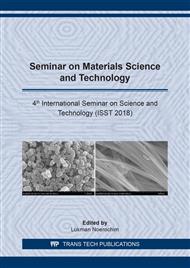[1]
N. Narang, an Updated Review on: Floating Drug Delivery System (FDDS),, Int. J. Appl. Pharm., vol. 3, pp.1-7, (2011).
Google Scholar
[2]
Kanekar Akhil S, Patil Ashwini B, Kanavaje Abhijit M, Khade Amol B, and Battase Anil P, Floating Drug Delivery System: A Comprehensive Review and Its Possible Scope,, IJPRR., vol. 4, p.183, (2014).
Google Scholar
[3]
Shah S. H., Patel J. K., and Patel N. V., Stomach Specific Floating Drug Delivery System: A Review,, Int. Journal of PharmTech Research, vol. 1, pp.623-633, (2009).
Google Scholar
[4]
William D. Chey, Grigorios I. Leontiadis, Colin W. Howden, and Steven F. Moss, ACG Clinical Guideline: Treatment of Helicobacter pylori Infection,, The American Journal of Gastroenterology, vol. 112, pp.212-238, (2017).
DOI: 10.1038/ajg.2016.563
Google Scholar
[5]
W. Sadée and G. C. M. Beelen, Drug Level Monitoring, John Wiley & Sons, Inc., (1980).
Google Scholar
[6]
A. Kotwal and A. K. Pathak, Formulation and Evaluation of Intragastric Buoyant Tablets of Amoxicillin Trihydrate,, IJPLS., vol. 2, pp.546-550, (2011).
Google Scholar
[7]
M. V. S. Varma, A. M. Kaushal, A. Garg, and S. Garg, Factors Affecting Mechanism and Kinetics of Drug Release from Matrix-Based Oral Controlled Drug Delivery Systems,, Am J Drug Deliv., vol. 2, pp.43-57, (2004).
DOI: 10.2165/00137696-200402010-00003
Google Scholar
[8]
H. K. Shaikh, R. V. Kshirsagar, and S. G. Patil, Mathematical Models for Drug Release Characterization: A Review,, World Journal of Pharmacy and Pharmaceutical Sciences, vol. 4, pp.324-338, (2015).
Google Scholar
[9]
M. H. Shoaib, J. Tazeen, H. A. Merchant, and R. I. Yousuf, Evaluation of Drug Release Kinetics from Ibuprofen Matrix Tablets Using HPMC,, Pak. J. Pharm. Sci., vol. 19, pp.119-124, (2006).
Google Scholar
[10]
M. V. Risbud, A.A. Hardikar, S. V. Bhat, and R. R. Bhonde, pH-sensitive Freeze-dried Chitosan–Polyvinyl Pyrrolidone Hydrogels as Controlled Release System for Antibiotic Delivery,, Journal of Controlled Release, vol. 68, pp.23-30, (2000).
DOI: 10.1016/s0168-3659(00)00208-x
Google Scholar
[11]
N. Wivanius and E. Budianto, Sintesis dan Karakterisasi Hidrogel Superabsorben Kitosan Poli(N-Vinilkaprolaktam) (Pnvcl) Dengan Metode Full Ipn (Interpenetrating Polymer Network) ,, Pharm Sci Res., vol. 2, pp.152-168, (2015).
DOI: 10.7454/psr.v2i3.3483
Google Scholar
[12]
S. Selvakumaran and I.I. Muhamad, Evaluation of Kappa Carrageenan as Potential Carrier for Floating Drug Delivery System: Effect of Cross Linker,, Int. J. Pharm., vol. 496, pp.323-331, (2015).
DOI: 10.1016/j.ijpharm.2015.10.005
Google Scholar
[13]
P. Sriamornsak, J. Nunthanid, K. Cheewatanakornkool, and S. Manchun, Effect of Drug Loading Method on Drug Content and Drug Release from Calcium Pectinate Gel Beads,, AAPS PharmSciTech., vol. 11, pp.1315-1319, (2010).
DOI: 10.1208/s12249-010-9513-x
Google Scholar
[14]
T. M. S. U. Gunathilake, Yern Chee Ching, and Cheng Hock Chuah, Enhancement of Curcumin Bioavailability Using Nanocellulose Reinforced Chitosan Hydrogel,, Polymers, vol. 9, pp.1-19, (2017).
DOI: 10.3390/polym9020064
Google Scholar
[15]
S. Banerjee, L. Siddiqui, S.S. Bhattacharya, S. Kaity, A. Ghosh, P. Chattopadhyay, A. Pandey, and L. Singh, Interpenetrating Polymer Network (IPN) Hydrogel Microspheres for Oral Controlled Release Application,, Int. J. Biol. Macromol., vol. 50, pp.198-206, (2012).
DOI: 10.1016/j.ijbiomac.2011.10.020
Google Scholar
[16]
N. Rositaningsih and E. Budianto, Characteristic of Starch-Poly(N-Vinyl-Pyrrolidone) for an encapsulation material in floating drug delivery system,, Materials Science and Engineering, vol. 191, pp.1-8, (2017).
DOI: 10.1088/1757-899x/191/1/012011
Google Scholar
[17]
F. A. Miller, and C. H. Wilkins, Infrared Spectra and Characteristic Frequencies of Inorganic Ions,, Analytical Chemistry, vol. 24, pp.1253-1294, (1952).
DOI: 10.1021/ac60068a007
Google Scholar
[18]
Ngo Le Ngoc and K. Takaomi, Ultrasound Stimulus Effect on Hydrogen Bonding in Networked Alumina and Polyacrylic Acid Slurry,, Ultrasonics Sonochemsitry, vol. 17, 186-192, (2010).
DOI: 10.1016/j.ultsonch.2009.04.007
Google Scholar
[19]
A. Martin, J. Swarbrick, and A. Camarata, Physical Pharmacy, 6th Ed., (2011).
Google Scholar


